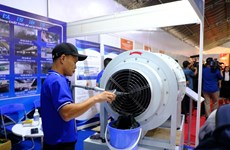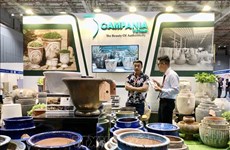Exporters may fall short of targets
Exporters are expected to earn an average of roughly 9.4 billion USD
monthly in the second half of the year to be able to meet the annual
target of 109.5 billion USD. However, it would not be easy as export
growth rates to several markets recently slowed down, according to the
Ministry of Industry and Trade.
Exporters are expected to earn an average of roughly 9.4 billion USD
monthly in the second half of the year to be able to meet the annual
target of 109.5 billion USD. However, it would not be easy as export
growth rates to several markets recently slowed down, according to the
Ministry of Industry and Trade.
The ministry said that it could be difficult for prices of agricultural and aquatic products to increase in H2. Nevertheless, it expected that the products will earn 10.7 billion USD from exports thanks to exporters' efforts to promote markets and the Government's credit supports, bringing the total annual export turnover to 21.1 billion USD.
For the group of raw materials and minerals, the ministry forecast the group to fetch roughly 6 billion USD in H2, bringing the total annual turnover to 11.6 billion USD.
The annual export value of processing products could reach 68 billion USD as the turnover in H2 is expected to be 34.8 billion USD.
To meet the target, the ministry has instructed relevant authorities to keep a close eye on export markets to have an accurate forecast. Vietnam's trade counsellors in foreign countries, especially key export markets, are also required to timely report changes to the ministry related to changes in policies to help local exporters adapt.
The ministry will also work closely with the Ministry of Finance to effectively implement the Government's credit support policies to help exporters access credit sources, promote credit guarantee for small- and medium-sized enterprises, adjust flexible import and export taxes, and further facilitate customs procedures.
To boost seafood exports, general secretary of the Vietnam Association of Seafood Exporters and Producers (VASEP) Truong Dinh Hoe said that trade barriers in major importing markets were big challenges facing the local fishery enterprises.
VASEP asked relevant authorities to take measures to rebound seafood exports to Japan . Seafood exports to Japan decreased sharply in the first six months of the year due to Japanese strict regulations. The contamination index in shrimp imposed by Japan is much lower than the current rules of the World Trade Organisation. For example, Europe and the US regulate the impurity content of 150 parts per billion (ppb) and 75 ppb, respectively, while the figure of Japan is only 10 ppb.
Hoe also recommended relevant agencies regulate certain criteria for local seafood exporters and reduce the number of the exporters from the more than 100 as of now to 60-70 in a move to increase quality.
Chairman of the Vietnam Leather and Footwear Association Nguyen Duc Thuan proposed that the Government should create favourable conditions to improve the competitiveness of export sectors.
Thuan said under the current Import and Export Tax Law, enterprises, which import supplies and raw materials for production of exported goods, would receive a 275-day grace period of duty payment for their imports. However, the draft of the revised Import and Export Tax Law eliminates the tax payment deferment and requires the enterprises to pay the tax before importing.
"This reduces the competition for exporters, particularly in the context of difficulties in the world market," Thuan said.-VNA
The ministry said that it could be difficult for prices of agricultural and aquatic products to increase in H2. Nevertheless, it expected that the products will earn 10.7 billion USD from exports thanks to exporters' efforts to promote markets and the Government's credit supports, bringing the total annual export turnover to 21.1 billion USD.
For the group of raw materials and minerals, the ministry forecast the group to fetch roughly 6 billion USD in H2, bringing the total annual turnover to 11.6 billion USD.
The annual export value of processing products could reach 68 billion USD as the turnover in H2 is expected to be 34.8 billion USD.
To meet the target, the ministry has instructed relevant authorities to keep a close eye on export markets to have an accurate forecast. Vietnam's trade counsellors in foreign countries, especially key export markets, are also required to timely report changes to the ministry related to changes in policies to help local exporters adapt.
The ministry will also work closely with the Ministry of Finance to effectively implement the Government's credit support policies to help exporters access credit sources, promote credit guarantee for small- and medium-sized enterprises, adjust flexible import and export taxes, and further facilitate customs procedures.
To boost seafood exports, general secretary of the Vietnam Association of Seafood Exporters and Producers (VASEP) Truong Dinh Hoe said that trade barriers in major importing markets were big challenges facing the local fishery enterprises.
VASEP asked relevant authorities to take measures to rebound seafood exports to Japan . Seafood exports to Japan decreased sharply in the first six months of the year due to Japanese strict regulations. The contamination index in shrimp imposed by Japan is much lower than the current rules of the World Trade Organisation. For example, Europe and the US regulate the impurity content of 150 parts per billion (ppb) and 75 ppb, respectively, while the figure of Japan is only 10 ppb.
Hoe also recommended relevant agencies regulate certain criteria for local seafood exporters and reduce the number of the exporters from the more than 100 as of now to 60-70 in a move to increase quality.
Chairman of the Vietnam Leather and Footwear Association Nguyen Duc Thuan proposed that the Government should create favourable conditions to improve the competitiveness of export sectors.
Thuan said under the current Import and Export Tax Law, enterprises, which import supplies and raw materials for production of exported goods, would receive a 275-day grace period of duty payment for their imports. However, the draft of the revised Import and Export Tax Law eliminates the tax payment deferment and requires the enterprises to pay the tax before importing.
"This reduces the competition for exporters, particularly in the context of difficulties in the world market," Thuan said.-VNA













